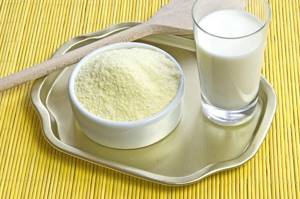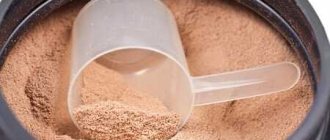How to calculate your protein dosage per kilogram of weight. What do scientists say about this? Useful tips and tricks. What could be easier than deciding on a sports nutrition norm? But this is just an illusion. When it comes to the technique itself, it all comes down to numerous and very useless experiments. Even eating protein is difficult. The reason is the inability to determine how much supplements should be taken per day. Let's look at this issue in more detail.
Let's start with quantity
In many “primer books” for athletes, the recommended protein intake per day is 2 g per kilo of weight. This figure can increasingly be found in newspapers and sports magazines. Many people accept this fact as an unconditional truth, measure out the required number of grams and start consuming protein. In fact, this dosage is not always optimal. That is, for an athlete who is actively involved in the gym, this amount of protein may not be enough. To achieve the effect, you should use the product in larger quantities.
On the other hand, the issue of dosage is not as clear-cut as it might seem. For example, according to official standards, it is enough to take 0.75 grams of protein per kilogram of weight, which is lower than the figure we mentioned. In turn, studies in Russia indicate other figures - 60-120 grams per day. According to scientists, this amount of protein is enough to cover the body's needs. An interesting fact is that the researchers do not specify exactly how much supplement should be given per kilogram of weight.
Another interesting fact. Scientists threaten that if you take 3 grams of food or more, you can get serious health problems. So who should you believe, and how much protein should you really consume?
Proteins and diseases
These animals, like others, are also susceptible to disease. They should not be overfed (especially small ones) - otherwise their metabolism will be disrupted, and at home they are limited in movement, which means they will become obese. The cage should not be placed on a window or in a draft. They also suffer from the same diseases as all mammals. This includes rabies, pulmonary diseases, colds, heart diseases, etc.
Babies always sleep together, curled up and hugging each other; may be covered with a tail.
To make friends with a squirrel, you need to treat it from your hands as often as possible, trying to get it to follow your hand. And only then can you stroke it freely. But we must not forget that the squirrel has a “short memory” and without regular communication it quickly runs wild.
Muscle building and current standards
To determine how much protein to consume, it is important to know exactly what your muscles need. On average, per hundred grams of our muscles there are about 15-20 g of protein. Thus, protein makes up one fifth of muscle mass. The rest is fat, ordinary liquid (water) and the dry residual part, which is minimal.
To build new muscle, you need about 200 grams of protein per kilo of existing meat. In this case, we are not talking about how much supplement to drink per day, but what amount of protein is needed in principle. For example, if you eat only one gram per day, then in a year your body will receive only 365 grams of the required element. If we consider that its share in muscles is only 20%, then the increase is 1825. As a result, to obtain such a volume of muscle, it is enough to take 1 g of protein per day for a year. Accordingly, if you consume 5 g per day, you can gain up to 10 kilos of pure muscle per year.
The philosophy described above is just a theory. It could work if the protein was used only for the muscles. But our organs also need protein every day. As a result, a serving of 1 g of protein will inevitably lead to an acute deficiency in the beneficial element, the accumulation of bad cholesterol and a number of other negative consequences. As a result, active blockage of blood vessels will begin, and so on. In general, there are countless problems.
How to stir the additive
Properly mix protein in a shaker . This is the most convenient option for obtaining a homogeneous mixture. A shaker is a measuring cup with a convenient lid and a closing spout through which you can pour the additive or simply drink it. After all the ingredients are placed in it, close the lid tightly and, using progressive smooth movements, shake the glass up and down until thoroughly mixed.
You can also stir a protein shake without a shaker. To do this, use a container with high sides and a mixer or a regular fork. The most important thing is that after consumption, you must thoroughly wash all the utensils used, preventing the remains of the cocktail from souring.
However, it is not enough to know how to stir protein; you also need to take into account the rules for storing it .
If you are going to take a drink to training, it is best to place it in a small thermos so that it does not have time to cool down in the cold season or sour in the heat. At home, the mixture should be stored in the refrigerator, however, no more than 3-5 hours. Proteins that contain creatine are consumed immediately after induction, since this amino acid degrades very quickly with prolonged contact with liquid.
If you know how to properly dilute a protein shake, the supplement will provide maximum benefit and be most fully absorbed in the body.
What are the real needs?
A normal person needs protein at the rate of 1 g per 1 kg of weight. But this dosage is not suitable for an athlete who leads an active lifestyle and constantly puts stress on his body. In this case, the portion may vary depending on a number of factors - a person’s age, his activity, activity, diet, and so on.
If we approach from the position of structure and muscle construction, we get the following picture:
- the basic requirement (that is, the required amount for the body and basic systems) is 1 g per day (based on a kilogram of weight). If you take protein in this volume, then all key needs will be covered;
- structural necessity for building new muscles. Here you need to take 10 grams of protein (per day). In this case, there is no need to focus on mass;
- additional need. How much is needed here? As a rule, it is enough to multiply the basic requirement by one and a half.
What is the result? To cover your daily needs, you need to take 1.6 g of protein per kilo of live weight. From a physiological point of view, this is enough.
The creative role of man in life
It is very surprising that the female squirrel is dominant and larger than the male. She easily took away the hazelnuts he had already peeled from the boy. Might drive him into a corner. In a word, the male was inferior to his neighbor. By November, we began to notice that the male had grown up and reached sexual maturity. But the female is not there yet. She didn't let him near. During this period - December - he called her, chased her around the cage, even bit her (she barely had time to hide from him), and in general there was a strong squeak. Everything dissipated when on February 26 we heard a faint squeak - near the house. Although before this I noticed that our pet eats a lot, has gained weight, has a rounded tummy, and folds her front paws and always holds them on her chest.
And her behavior before giving birth was a little strange. She deftly collected the hay with her paws, crushed it, crumpled the hay and brushwood with her teeth, and then dragged it to a secluded, quiet place in the cage - behind the house.
What's the mystery?
If everything is so simple, then why do athletes who take 2-3 g per kg of their weight gain muscle much faster. To calculate how much protein to take, it is important to take into account one more detail - the digestibility of the body. That is, each person takes protein with different effectiveness. For one it is enough to consume 1.5-2 g per kilo, while for another 2.5-3 grams is not enough. The body can absorb 40% or more of the resulting protein. However, this number differs for everyone. One can only guess how much the muscles will actually gain.

Meet the Squirrels
This is an animal with an elongated body and a long fluffy tail. The length of my pets is 22cm (at the age of 21 months) and weighs about 600g.
The lifespan of the animal in the wild is 7 years, in captivity - more than 10 years. The head is rounded, the nose is slightly elongated, the eyes are large and black and located on both sides of the head. The ears are relatively long, with long tassels at the ends of the same length, but only in winter; in summer there are no tassels. The hind legs are very powerful and large, and the front legs are short, with which she holds and deftly and quickly turns over the objects she needs. The fingers are elongated, with extremely tenacious claws. The color of the fur depends on the season, from silver-gray in winter to bright red in summer, but the pet’s belly is always light white. In winter, the fur is always soft and fluffy. The animal's tail is very fluffy and long - about 25 cm and helps them maintain balance when moving, and also plays the role of balance when jumping for a long time onto a tree or onto the ground.
Results
Let's try to draw the right conclusions. Protein is necessary for every body and must be consumed regularly (this is beyond doubt). Another thing is that the ideal norm for yourself will have to be selected individually, based on the results obtained and internal sensations. In doing so, follow these tips:
- take only high-quality product;
- distribute supplement doses 6-8 times;
- the dosage at a time should not exceed 10-20 g;
- start with small portions.
Description of the nest
The cage in which the squirrels live should not be small - approximately 200x150x100cm, so that it is convenient for them to jump. There you need to lay out sticks, thanks to which the squirrel will grind off its claws. Hang two houses or hollows, a drinking bowl, and sprinkle everything below with hay or sawdust. It is useless to put food in the feeder; the squirrel will hide it anyway. The cage must be removed from the husks and even treated for parasites once every three months. Squirrels are clean animals and will clean their house themselves.
All day long they rush around the cage, while a clattering sound can be heard, and if this clattering sound is present, then at the same time there is also stomping of the hind legs and wagging of the tail. It is very interesting to listen to how the male calls the female - it is a strong, drawn-out cry.
Difficult times for animals come during molting. In males, molting occurs earlier and lasts until June. In females a little later. At this time, they acquire bright red fur and lose the tufts on their ears. Autumn molting begins at the base of the tail and the growth of the tassels, and this happens at the end of summer - after the rut, again the males are the first to molt. During this period, the squirrels do not look very beautiful; the fur seems to hang in clumps.
How long does diluted protein last?
On average, manufacturers indicate that diluted protein can be stored for several hours; this mainly depends on the liquid in which the dilution was made, on the air temperature and on the cooking conditions: the microbiological cleanliness of dishes, hands and the air in the room where the products were measured. Milk, even sterilized, in a cocktail sours very quickly without refrigeration, and it is irrational to store it for more than 2-3 hours. In essence, the “life” period of a diluted cocktail is enough for the duration of training, so that you can drink half of the cocktail before and half after it.
How to dilute protein with water
Many people are interested in what is better protein with milk or water ? If you don't have it with you
milk or there is an intolerance to it, then for dilution you can use ordinary water, compote or juice. Water should be chosen by those who are trying to reduce the daily calorie intake and by athletes who are cutting; this option is also more budget-friendly.
How to properly dilute protein ? Pour water into a shaker or glass, add the required amount of protein and shake well.
Protein made with water is less tasty, but lower in calories. Instead of plain water, it is allowed to use carbonated unsweetened water, mineral or any other, as long as it is boiled, filtered or purchased.
Can protein be diluted with hot water ? Diluting protein with hot water is prohibited, since proteins coagulate under the influence of high temperatures, in addition to which the amount of useful substances decreases.
In what water should the protein be diluted, warm or cold ? It is best to dilute in warm water, since in cold water the mixture may not mix well and the cocktail will contain lumps.
Slow protein
Slow protein is one that is absorbed by the human body over a long period of time. As a rule, this requires about 7 hours. The slow type of protein is actively used by those people who plan to create a sculpted figure and also get rid of excess weight. To gain muscle mass, slow-acting proteins are taken before bed. As a rule, the muscles receive the required portion of amino acids overnight. Slow protein is also consumed between meals.
The goal is to lose weight
If the main goal is not gaining muscle mass, but losing weight, then you need to follow the following strategy. Firstly, food should be taken 5-6 times a day and in small portions. Secondly, if you can’t have a snack, then 2-3 meals can be replaced with a hearty protein shake (you can use whey protein for preparation). The advantage of such a snack is the absence of carbohydrates and fats, which significantly helps in losing weight. In addition, if there is a large “gap” in food intake, it is advisable to take a portion of casein (it will provide a feeling of fullness and give everything the body needs).

Quality of Protein Powder
The ideal protein for a person contains per 1 gram:
- Isoleucine - 40 mg.
- Leucine - 70 mg.
- Lysine - 55 mg.
- Methionine and cystine in total - 35 mg.
- Phenylalanine and tyrosine in total - 60 mg.
Protein corresponding to mother's milk is considered ideal for growth. Whey protein came closest. On the market today there are: whey, egg white, casein, soy, wheat protein. Plant protein is incomplete; for example, wheat protein contains little lysine.
How to dilute whey protein? Just like anyone else. Whey protein is nothing but proteins derived from whey.

Complete protein
Complete protein is a mixture of different types of protein. This is the best type of protein in terms of action and digestibility in the body. In one complex, a person can simultaneously receive casein, egg, whey, and soy protein, which means all their best indicators. A complex protein is made from whey. This product has a high level of biological activity. It is recommended to drink such cocktails immediately after physical activity. The advantage over other types of protein is its low cost. Speaking about when to take complex protein, you need to note that it is best to do it 2 hours before the start of training. A cocktail is also drunk between meals and before bed.
Most popular questions:
— Is it possible to dilute protein in kefir?
— Yes, kefir is a dairy product that contains amino acids, as well as lactic acid bacteria, which help improve the absorption of the supplement. In addition, kefir is an ideal product for those suffering from lactose intolerance.
— Is it possible to mix protein with juice?
- Can. The juice contains fructose, as well as a large amount of vitamins, minerals and other nutrients. And, in addition, the taste properties of the protein, when diluted with juice, are significantly improved.
— How to dilute protein: proportions?
- Usually this is 250 ml or more of liquid, which is diluted with 20-30 grams of dry mixture. The main thing is not to exceed the daily protein requirement, which is calculated according to the formula - 2 gkg of your own body weight.
— What kind of water should you dissolve protein in?
— Protein must be dissolved in boiled, mineral or filtered still, warm water.
— Is it better to dilute protein with water or milk?
— It is better to dilute protein in milk, as it is rich in amino acids and carbohydrates, which are essential for the growth of muscle mass during active training.
How to dilute protein with milk

Many novice athletes are interested in what and how to dilute protein ? One of the popular and common products for diluting protein is milk, which should be selected taking into account the following features:
- When diluting protein with milk, you should look at the body's reaction, since unpleasant symptoms may occur due to lactose intolerance.
- What is the best thing to mix protein with ? For protein breeding, the choice of a specific type of milk, be it UHT, fresh or whole, is not important. Almost each of them has the same ratio of proteins, fats and carbohydrates, the only thing you should pay attention to is the fat content of the dairy product, because if there is no goal of gaining weight, then low-fat milk should be used to dilute the protein.
- What should you mix protein with ? Some types of protein are difficult to dissolve in milk compared to water, so before purchasing you should inquire about this feature so that lumps do not form after stirring.
- When consuming protein in the morning, it is preferable to use milk, while in the evening it is better to use water, since the slow protein of milk impairs the absorption of protein.
- When deciding to gain weight, the combination of milk and protein is ideal; such a cocktail will serve as a good impetus to start the process. A glass of milk contains about 70 calories and 6 grams of protein. At one time, the body is able to absorb about 30 g of protein; this should be remembered when taking it, since undigested protein is deposited in fat reserves.











